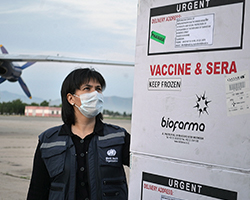Vaccines for supplemental polio vaccination campaign arrive in Tajikistan

WHO
On Sunday, 23 May 2021, 4.6 million doses of novel oral polio vaccine type 2 (nOPV2) arrived in Dushanbe, Tajikistan. These vaccines will be used for a nationwide poliomyelitis (polio) immunization campaign planned for May to July 2021 in response to the ongoing outbreak. During the campaign, almost 1.4 million children under the age of 6 will be targeted to receive the vaccine to strengthen protection against type 2 poliovirus.
The response activities are led by the Ministry of Health and Social Protection of the Population of Tajikistan and supported by the United Nations Children’s Fund (UNICEF), WHO and other partners within the Global Polio Eradication Initiative (GPEI).
Detailed preparations for the campaign included capacity-building on vaccine management, vaccine safety and social mobilization, and planning for the monitoring and evaluation of the upcoming 2 rounds of vaccination.
In addition to fixed vaccination points at health facilities, mobile teams will be operating in hard-to-reach areas to ensure that every child is protected from this crippling disease.
The polio campaign is supported by the GPEI, a consortium dedicated to the eradication of polio. The GPEI is spearheaded by national governments, Rotary International, UNICEF, the United States Centers for Disease Control and Prevention (CDC) and WHO, and supported by key partners including the Bill & Melinda Gates Foundation and GAVI, the Vaccine Alliance.
Cases of poliovirus in Tajikistan
Since November 2020, 9 cases of acute flaccid paralysis confirmed to be caused by circulating vaccine-derived poliovirus type 2 (cVDPV2) have been reported in Tajikistan. They are all linked to an imported virus strain currently circulating in Pakistan. Poliovirus surveillance in Tajikistan has been stepped up, and environmental surveillance has been established.
In February 2021, the country completed a planned nationwide inactivated polio vaccine (IPV) catch-up campaign to ensure that all children who may have missed receiving protection against type 2 poliovirus in the past are protected from becoming sick and suffering potential paralysis should they come into contact with the virus.
The supplemental campaign will be conducted using nOPV2. This vaccine has been improved to provide comparable protection against poliovirus while being more genetically stable than monovalent oral polio vaccine type 2 and therefore less likely to revert into a form which can cause paralysis in under-immunized communities.



